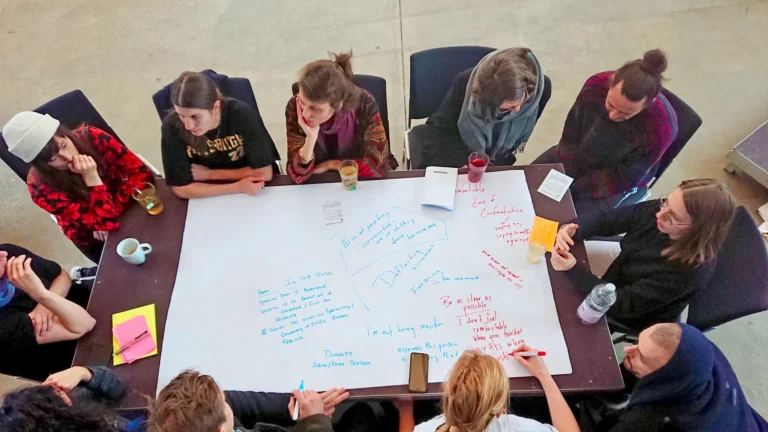Briana Rainey, a senior at Wayne State University in Detroit, Michigan, never dreamed her dance pedagogy course would lead to work with a demolition crew. But to fulfill one of the class requirements, she rode to work for several days in the back of a pickup truck with men who supported their families by performing backbreaking labor without benefits like health insurance or the promise of steady employment. “Many of my co-workers talked about their daughters’ love of dance or about other activities they could no longer participate in due to lack of resources,” says Rainey. “Until then, I always thought of dance as an easily accessible activity because it was always available to me.”
This is just the kind of realization the course’s dance professor, Doug Risner, had in mind. His pedagogy course is designed to take students beyond their familiar range of experiences. Mandatory for all dance majors at Wayne State, the course incorporates readings and class observations to introduce different points of view and approaches to teaching. Students are also required to take on an experiential project, like Rainey’s. Risner’s goal is to develop reflective, empathetic educators able to work in various settings and with diverse populations. “It gets students thinking about their responsibility for other people’s learning,” says Risner.
Since more standard pedagogical fare like teaching methods and classroom management are covered in a separate course, Risner is free to focus on building what he calls personal pedagogies. He begins by asking students to examine their own histories for insight into effective teaching methods they’ve encountered as students. But much of the class focuses on the experiences of others.
Throughout the semester, students explore racial, gender, socioeconomic and sexual orientation differences and how mainstream education sometimes unwittingly adopts assumptions. The students also do field observations in various educational settings—public schools, recreational centers and other colleges—to compare different points of view, teaching styles and students. Students are graded on summary and position papers they write in response to the readings, on the notes they take during observations and for their participation in class discussions.
But to give his students a physical sense of what it’s like to live in another person’s skin, Risner has them step out of the classroom to complete what he calls a social immersion project. His syllabus suggests things like volunteering in a homeless shelter, wearing the same thrift-store-bought clothes for one week or spending just 74 cents per meal for seven days.
Before taking Risner’s course, senior dance education student Felicia Rose did some teaching in the Detroit public schools. “I remember a teacher telling me that it’s hard because you don’t know if these children had breakfast or even dinner,” says Rose. “You can have a perfectly well-behaved student one day and the next day they are angry and emotional. I thought she was crazy.” But after limiting herself to 74 cents per meal for a week, Rose had a physical sense of what such deprivation can do. “It made me realize how much hunger can affect your daily patterns, emotions and behavior,” she says.
Rose also saw how a limited budget affects the quality of diet. “The first day I was buying food, I realized you can’t get all those fresh fruits and vegetables or buy the name brand just because it’s low-fat,” says Rose. “People keep talking about children being obese, but how can we stop it when cheap foods are fattening and full of preservatives?”
Risner says when students first hear of the social immersion project, many worry about whether they’ll be able to do it. He admits that completing it is difficult. “I struggle to help my students digest it and to support them intellectually and emotionally,” he says. To receive a grade, each must submit written reflections on what they learned and present their findings to the class. “They are often brought to tears as they present their work,” says Risner.
And though Risner considers commitment to the project when grading, a student’s analysis of why they weren’t able to complete it to the letter often more than makes up for their straying.
This was true for Rainey. She undertook her project with the help of her father, who runs a construction company demolition department and employs men from his neighborhood as laborers. During her stint with the crew, they did some sewer work and mold removal. “A few times I had to leave the area because my father didn’t want me exposed to unsanitary conditions,” says Rainey. Reflections on the different treatment she received were part of her final project.
Similarly, Rose admits to splurging on a couple of bottles of water after dance class and not counting them in her 74 cents per meal plan. “The saddest thing about it is if I was really in this situation, then I would have just spent my gas money or a part of my mortgage payment,” she says. DT
Janet Weeks is editor of Dance Magazine College Guide and a contributing editor to Dance Teacher.



